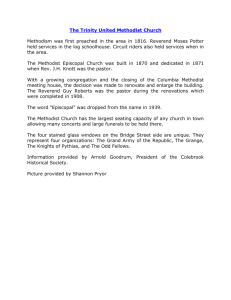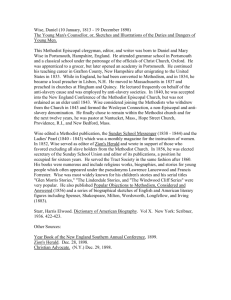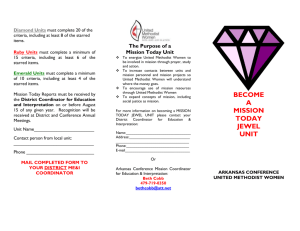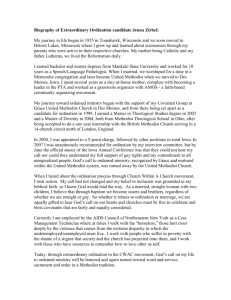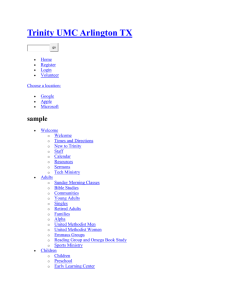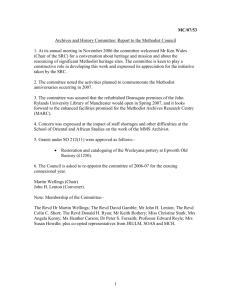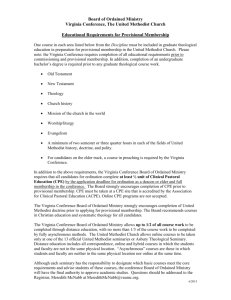Episcope and Oversight in British Methodism
advertisement
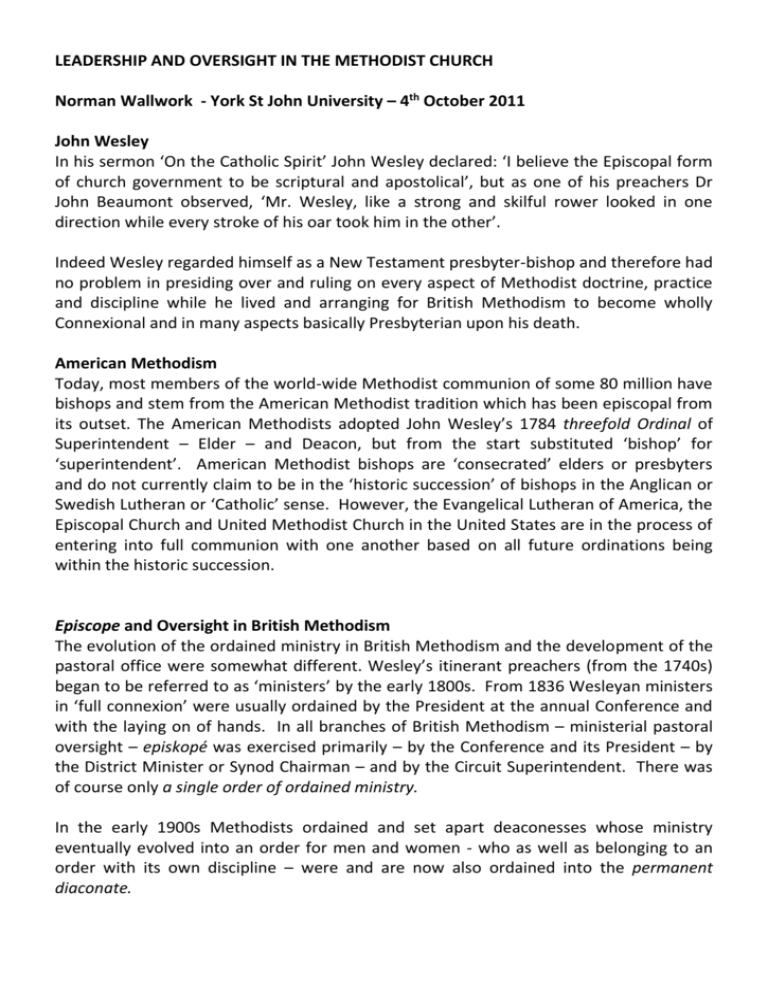
LEADERSHIP AND OVERSIGHT IN THE METHODIST CHURCH Norman Wallwork - York St John University – 4th October 2011 John Wesley In his sermon ‘On the Catholic Spirit’ John Wesley declared: ‘I believe the Episcopal form of church government to be scriptural and apostolical’, but as one of his preachers Dr John Beaumont observed, ‘Mr. Wesley, like a strong and skilful rower looked in one direction while every stroke of his oar took him in the other’. Indeed Wesley regarded himself as a New Testament presbyter-bishop and therefore had no problem in presiding over and ruling on every aspect of Methodist doctrine, practice and discipline while he lived and arranging for British Methodism to become wholly Connexional and in many aspects basically Presbyterian upon his death. American Methodism Today, most members of the world-wide Methodist communion of some 80 million have bishops and stem from the American Methodist tradition which has been episcopal from its outset. The American Methodists adopted John Wesley’s 1784 threefold Ordinal of Superintendent – Elder – and Deacon, but from the start substituted ‘bishop’ for ‘superintendent’. American Methodist bishops are ‘consecrated’ elders or presbyters and do not currently claim to be in the ‘historic succession’ of bishops in the Anglican or Swedish Lutheran or ‘Catholic’ sense. However, the Evangelical Lutheran of America, the Episcopal Church and United Methodist Church in the United States are in the process of entering into full communion with one another based on all future ordinations being within the historic succession. Episcope and Oversight in British Methodism The evolution of the ordained ministry in British Methodism and the development of the pastoral office were somewhat different. Wesley’s itinerant preachers (from the 1740s) began to be referred to as ‘ministers’ by the early 1800s. From 1836 Wesleyan ministers in ‘full connexion’ were usually ordained by the President at the annual Conference and with the laying on of hands. In all branches of British Methodism – ministerial pastoral oversight – episkopé was exercised primarily – by the Conference and its President – by the District Minister or Synod Chairman – and by the Circuit Superintendent. There was of course only a single order of ordained ministry. In the early 1900s Methodists ordained and set apart deaconesses whose ministry eventually evolved into an order for men and women - who as well as belonging to an order with its own discipline – were and are now also ordained into the permanent diaconate. British Methodism and the 2 Historic Episcopate (a) The Anglicans, Methodists, Presbyterians and Congregationalists who formed the Church of South India in 1947 concluded that a fully integrated and united church could only come into being with the ‘universal’ and ‘continuity’ model of ‘bishop, presbyter and deacon’. The episkopé of CSI bishops would be exercised in close association with their synods. The bishops of the united church – drawn from all four uniting traditions - would be (e.g. Bishop ‘in Mysore’ and not ‘of Mysore). (b) In 1970 the main Anglican and Protestant traditions of North India and Pakistan followed with the same threefold ministry of bishop, presbyter and deacon. (c) During the last 80 years - from the late 1930s - the British Methodist Conference has voted five or six times overwhelmingly in favour of a three-fold ordained ministry for British Methodism that includes episcopacy and with a commitment to its Methodist bishops being ordained within ‘the historic succession’. (d) On each occasion the vote in favour was given on the clear understanding that this new ordering of Methodist ministry was within the context of the re-union of the Church and that Methodists would not take on board either episcopacy or the ‘historic succession’ for its own sake. (e) At the same time British Methodists were willing to see and accept episcopacy as a gift to its further life and not just a name or title to make others happy. Those churches that ‘give’ Methodism the historic episcopate are entitled to a guarantee that we would ‘use it’ and not ‘abuse it’. The gift of the historic episcopate could be given to British Methodists from Anglican and Lutheran and Ecumenical traditions. (f) World-wide Methodism has committed itself to taking seriously the LIMA Statement of 1982 and thus affirms that whilst all Christians are called to general ministry and many to specific ministries – pastoral, liturgical and administrative – there are three universal patterns of ordained ministry – bishop – presbyter – deacon. Deacons represent the servant ministry of Christ and the whole church. They link the church’s worship with its service. They lead in word and prayer and teaching. They often enable things to happen. Presbyters preside at word and sacrament. They teach the faith and have pastoral oversight. They have a principal and directing part in the local congregation. They prepare members for Christian life and ministry. Bishops preach and preside in worship and administer the church’s discipline. They provide regional continuity, unity and leadership. 3 They lead a region of the church in its mission. They offer a regional voice. They represent the whole church at the ordination of deacons, presbyters and other bishops. They provide personal episkopé integrated with the corporate episcope of the church’s governing body and the collegial episkopé with other bishops and ministers. (g) The receiving by British Methodism of the historic episcopate would involve Methodism making that gift its own. Methodist bishops would be like others bishops yet unlike them. Just as Lutheran bishops are not like Orthodox bishops, and CSI bishops are not like Catholic or Coptic bishops – so Methodist bishops would not need to be like Anglican bishops. Many English Anglican bishops could be among the first to shout Hallelujah at the prospect! But Methodist bishops would need to relate to bishops in other traditions! What of the existing episkope of the Methodist Conference and of bishops? Presently, the British Methodist Conference teaches the faith with authority and adjudicates on doctrinal matters. The Conference determines the practice of the Methodist Church and makes the rules. The Conference ordains through its deputed instruments, and the President of Conference, always a presbyter, presides at ordinations (another presbyter, invariably a Past President may be deputed by the Conference topreside at an ordination on the President’s behalf). The President presides at ordinations by virtue of presiding at Conference – a significant conjunction of ideas. The Conference deploys all ministers and deacons and also certain lay officers within the Methodist Church. The Conference and its officers exercise pastoral discipline throughout the connexion in accordance with the rules of the Church. Because the Conference exercises an episcopal type of ministry, it is appropriate to regard it as a corporate bishop – a phrase and concept increasingly recognised among British Methodists. In a very real sense the Conference is, as it were, the bishop for the Methodist Church. Because the Conference is the ‘bishop’ and the Connexion is ‘the bishop’s’ community, the connexion can be seen as having certain key characteristics of a diocese within the Christian Church – albeit an exceptionally large one! On the road to re-union or organic unity it is not episkope (as oversight) that is in new among British Methodists, but the language of personal episkope. Only recently has there been talk of the strongest expression of Methodist personal episkope residing in the office of the President of Conference. 4 The President of the Conference not only presides at ordinations, but, with the VicePresident, speaks on behalf of the Conference, gives spiritual and pastoral leadership to the Conference and to Methodists throughout the connexion, usually through intensive visitation, and also by relating to the leaders or senior pastors of other churches. Together with the Vice-President, the President is a focus of unity and (is perceived) as a leader in mission. In many ways – between each annual Conference the President is the Conference. The role of the President of Conference is the fullest expression of personal episkope that the Methodist Church knows. A President Bishop - A Proposal of the Anglican-Methodist Joint Implementation Commission from ‘Embracing the Covenant’ 2008 In re-visiting the question of British Methodism becoming an episcopally ordered church, the Anglican-Methodist Joint Implementation Commission (the JIC) suggests that the most appropriate way of bringing this about would be for the President of Conference to be the first bishop. By incorporating the President into the historic episcopate of the universal Church there would be a recognizing of what is already the case, that the President exercises an ‘episcopal’ ministry on behalf of an ‘episcopal’ Conference. The JIC believes that it would be a desirable and proper step for this recognition to be given. The Methodist Church would not be creating an episcopate from nothing, but giving appropriate recognition to what is already true, and building on both corporate and personal episkope in their fullest expressions within British Methodism. An episcopal President of Conference would be a bishop for the whole Methodist Connexion, which already has certain characteristics of a very large diocese. The JIC recommends that the episcopate should continue to be closely connected to the office of President, as an already de facto ‘episcopal’ ministry and as the locus of a Methodist episcopate that would be least controversial and which would command the broadest support among Methodists and which would also commend itself to other churches that are ordered in the historic episcopate. The JIC is suggesting that one way of achieving this would be by each incoming President being ordained bishop for the whole Methodist Church. Within a few years, on the present system, there would be small group of bishops, ordained for a lifelong ministry, serving throughout the connexion. 5 Active outgoing presidents, while continuing to be appointed to districts, circuits or institutions, would retain (as they do now) a recognised Connexion-wide ministry, closely related to the identity of the Methodist Church – a role that is entirely appropriate for a bishop. If this episcopal team came to be regarded as, in effect, a ‘college’ of bishops (made up of the President-bishop and Past President-bishops), there would be alongside a ‘college’ of Vice-Presidents, whose members similarly already have an acknowledged role in the Connexion. Marks of a possible Methodist episcopate The JIC is promoting a personal episcopate based on the Methodist presidency because: It would be a collegial episcopate: the bishops (current President and former Presidents) would work with each other and the current President, as primus inter pares, would convene them. It would be a flexible episcopate – with the Connexion remaining, as it were, the only Methodist ‘diocese’. It would be a pioneer episcopate - with the Methodist Church would be exploring fresh forms of episcopal ministry. It would be an accountable episcopate - because it would be subject to Conference and carry out a ministry of unity and mission on behalf of Conference. It would be an earthed episcopate, because the ex-President bishops would continue to serve in their previous appointments and exercise episcopal duties further afield. It would be an ecumenical episcopate - relating to the bishops of the other episcopal churches within Britain. It would be an apostolic episcopate – bearing a visible testimony to the churches and to the world of the Methodist Church’s abiding intention to ordain to the ministry of the Church of Christ. It would be a covenantal episcopate, because bishops of the Methodist Church and of the Church of England (in particular) would work closely and collegially together, with mutual participation in ordinations and sharing in bishops’ collegial gatherings. Challenges to the Church of England 6 The JIC envisages the Methodist taking up of the President-bishop model to be a likely challenge to the Church of England because it would set before the Provinces of Canterbury and York the model of a pioneering episcopate as a – ‘fresh expression’ of episcopal ministry! The JIC is suggesting that the collegial character of a Methodist episcopate, operating collaboratively throughout the Connexion, might challenge the Church of England about how it practises episcopal collegiality. The JIC is suggesting that the Connexional nature of a Methodist episcopal ministry could challenge the Church of England to be a more united church, with more internal coherence. The JIC is suggesting that the recent trend for dioceses to collaborate and to share resources could be given a boost. The JIC is suggesting that the close relationship between Methodist bishops and the Conference would parallel the Anglican understanding of ‘the bishop in synod’, and these models could be mutually enriching alongside the particular responsibilities that bishops in the Church of England have to guide the church in matters of doctrine, liturgy and ministry. The JIC is suggesting that the fact that a Methodist episcopate, within the historic episcopal succession, would be open to women from the very beginning would need to be taken seriously by the Church of England as it seeks to implement the General Synod’s intention to make it possible for women to be ordained bishop in the Church of England, while seeking to hold itself together as a Church. The JIC is suggesting that this is the only way possible for Anglican and Methodist bishops, presbyters and deacons to work together on equal terms. ‘Leading and Presiding’- the title of a recent Methodist proposal for developing the Presidency of the Conference. The Methodist Conference of 2010 received a report on reminding Methodists that the President and Vice-President are the chief officers of the Conference and represent its authority both within the Methodist Church and in the wider world. 7 The President and Vice-President are called to offer leadership to the Conference itself while it is in session and to the wider Methodist Connexion throughout their year of office. Along with the General Secretary of the Conference the Presidency is expected to hold before the Methodist Church a vision of its calling and to challenge and encourage it to respond. On the one hand the General Secretary is directly responsible for the Connexional Team at headquarters, for the coordination of Connexional initiatives through the Connexional Leaders’ Forum and for the delivery of agreed programmes. On the other hand the President and Vice-President having no management responsibilities have an ambassadorial role and are free to travel widely in the Connexion giving a sense of the wholeness to the parts and feeding back to Connexional counsels their sense of local concerns. One of the recent working party’s principal recommendations was that the offices of President and Vice-President should be made more genuinely collaborative, thereby exemplifying a model of leadership for the whole Church. The working party recommended that there should be constitutional provision for collaboration in a wide range of duties. There have also been renewed calls for the President to hold office for longer than one year. The report pointed out that one of the chief arguments for this – continuity in leadership – has been largely met in recent years by the introduction of the General Secretaryship. Any revived hope that the media would take more notice of a longer-term President was unrealistic. In the several years that Dr John Newton was Moderator of the Merseyside Churches Archbishop Derek Warlock and Bishop David Sheppard had to insist that their Free Church colleague was pictured between them in order not to be cut off the photo as it was being prepared for the press! Whatever the honour and prestige accompanying an Anglican, Orthodox or Catholic bishop a Methodist President has roughly the fate of the out-going Scottish Moderator – one of whom observed that although he arrived at the General Assembly chauffer-driven and with police outriders he went home at the close of the Assembly’s first session as the ex-Moderator on the top of the No. 3 bus! 8 For a number of reasons the ‘Leading and Presiding’ package of proposals for developing the Methodist Presidency has recently received a negative response from the Methodist Conference. However, this will not prevent some of the better suggestions about collaborative styles being introduced into the Presidency regardless of how long each President and VicePresident hold office and regardless of the dropping of the notion that the title of the Vice-President should be changed to Co-President. It is already the case that the incoming President and Vice-President along with the two current holders of the office together with the two immediate past holders meet and work collaboratively as a six-fold Presidium. What Methodist response could be made to the twin foci in the title at this symposium - The Challenge of Leadership in a Changing Church? The Changing Face of Methodism Perhaps we need to look at the changing church before we ask about its leadership – though the experience of all our traditions may suggest that an unchanging leadership is often in place well ahead a changing church! Methodism is certainly a changing church! British Methodists are a shrinking community with a seriously aging membership and a consequent rise in the average age of their candidates for ordained ministry, a marked drop in the length of ministerial training and formation and perhaps therefore its overall quality. This does not however prevent the existence of some vibrant congregations some of them overtly evangelical and indeed charismatic. There are other very fine neighbourhood congregations and small, faithful and caring congregations who with their ministers, leaders and regional policy gave not abandoned the challenge of the city centre. By and large British Methodism is not racked with unsettled and unresolved tensions over human sexuality nor with issues around women’s ministry though in this latter case British Methodism is not devoid of glass ceilings. Your typical Methodist congregation is no longer traditionally Methodist. In a commuter village, an industrial town or a university city the Methodist congregation is unlikely to have a majority of cradle or life-long Methodists. More than half the regular worshippers and of the involved leadership might easily be liberal Baptist, Reformed, Anglican, ex Independent Evangelical, lapsed Roman Catholic, escaped Brethren or even new to the faith who just happen to have chosen that particular Methodist congregation because it was near, because it was friendly, because it had a lively Brownie pack, because one had married into it or surprise, surprise it had faithfully offered Christ in a course specifically aimed at attracting outsiders to Christianity. 9 The Challenge of Leadership in Local Methodism The leadership that most of our churches has received has been inherited from tradition and often indeed protected by law. Although the balance varies from one Christian communion to another – for all of us – leadership of the church in mission and ministry is a combination of local, regional and national – and of course for some international. We leave aside those who have a high doctrine of episcopacy and low doctrine of bishops and indeed those who have a high doctrine of the papacy but a low doctrine of the Vatican, and also those of whom John Habgood once remarked that though they had huge problems with papal infallibility they seemed to have no problem with their own! Almost all Methodist congregations have the pastoral oversight and leadership of an ordained presbyter who in a famous phrase from the Methodist Deed of Union ‘has a principal and directing part’ in the life of the local church. It is unlikely, of course, that the quality or size of any congregation will increase without the gifts, faithfulness and nourishment of the one in pastoral charge. The best of them tend to be good team players, to have a vision and to be able to share it. Though the British Methodist Connexion has nothing corresponding to the largely independent and autonomous Anglican diocese it does have thirty plus Districts. These are presided over by a District Chair – an office created in the 1790s after Wesley’s death. The District Chair has a key role in the stationing of ministers, in the initial offer and selection of candidates for ministerial training and in the deployment of specialist ministries. The District Chair represents his or her District ecumenically within a region, is a rarely consulted regional spokesperson and in council with their Fellow-Chairs can sometimes exert pressure on the thinking at Methodist headquarters. The key unit beyond the local Methodist congregation is the circuit - presided over by one of its presbyters appointed by Conference as the Superintendent. If there is a mind so to do the Circuit and the Superintendent can be instrumental in closing down a failing congregation, beginning a new one and deploying circuit staff – ordained and laystrategically. Mission and justice projects – often ecumenical by nature – even if locally conceived are heavily dependent on the backing and commitment of the Superintendent and the circuit. There is currently a huge trend connexionally to amalgamate existing British Methodist circuits - with some of the newly created ones being almost coterminous with a county or diocese. The newly created Gloucestershire circuit has replaced five existing circuits, and apart from its new Superintendent and its ordained ministry, it has completely revamped its structure and re-defined and renamed its principal officers. 10 Alongside the penetrating national annual property and financial schedule the Gloucestershire circuit has produced its own equally penetrating annual schedule about the witness, outreach and quality of each of the circuit’s 48 congregations. The circuit has devised its own ministerial appraisal system and in the first week of its existence the circuit abolished forty-two of its inherited committees! The Current Challenge of Leadership in Methodism Because British Methodism is a Connexion its past strengths and it present hopes are heavily dependent on the vision, policies and strategy of those at the centre. Because the Methodist Presidium changes every few years the most effective leadership is that of the Secretariat. In former times Methodist seismic shifts have come from previous Secretaries of the Conference. After the death of Wesley the chief architect of Methodist advance was Jabez Bunting who was occupied with the Secretariat of the Conference for sixteen years and held the Presidency on four occasions. He turned round the first significant decline in Wesleyan Methodist membership by the lead he gave in the creation of the 1820 ‘Liverpool Minutes’ – a penetrating series of resolutions which recalled every Methodist pastor and preacher to a renewal of field-preaching, ‘home mission’ outreach, public prayer meetings, attention to children, young people and the lapsed, pastoral visitation, Sunday observance, attendance at the Lord’s Supper, the preparation of a catechism, quarterly schedules, and days of fasting and prayer. Each generation of Methodists has been able to single out a Secretary of the Conference or a key figure in one of the national Mission Departments who through something like the early 20th century Forward Movement and the promotion of city Central Halls has enabled the whole church to change gear and think outside the box about the renewing of the life of the whole church. By far the brightest contemporary hope on the Methodist horizon nationally is Martyn Atkins, the current General Secretary of the Conference. Martyn insists that God does not shape the mission to the Church, but reshapes the Church around God’s mission of reaching out, redeeming and restoring and that Methodist ecclesiology is essentially missiological . Methodism needs to revisit why God raised her up in the first place and needs to read the signs of the times, to take seriously that it lives in world radically different to that of its founding mothers and fathers, and therefore although the original God-given charisms remain, how they are expressed and embodied changes. The continuing call of God to the People called Methodist involves fresh expressions of our DNA, for today. It is more about raising children than making clones. 11 In his vision of Contemporary Methodism: A Discipleship Movement Shaped for Mission Martyn Atkins is expecting the Methodist central resources to be used to encourage and lead Methodist circuits to re-form small leadership teams, to prioritize work with children and young people, to identify, train and resource and strategically place new Superintendents. Every circuit and minister will be expected to understand and accept that ‘pastoral charge’ will be seen equally as ‘missional charge’. The whole Connexion and each circuit will be expected to revisit the model of a local and ordained pastor in every church. There will be a thorough national, regional and local review of the training and continuing development of local lay preachers. There will be a new and radical approach to rationalizing a situation in which national Methodist membership and Sunday attendance has far too many church buildings. The chapels remaining will need to be regrouped for mission. Existing centres of excellence will need to be nourished and resourced. A central priority will be the re-establishing of a sense of the nearness and transcendence of God in acts of Methodist worship that are vital, majestic, challenging and enthralling and all of this in congregations that know both why they are gathering and why they are dispersing. Martyn Atkins believes that without a rediscovery of the call to holiness and to risk British Methodism cannot regain its place of God’s purposes. Each local Methodist community and its leadership must prioritize – perhaps even disproportionately - the making of new disciples in appropriate and apt ways that are clear, gracious and intentional. In this evangelistic ministry we are not recruiting for the church but offering God’s love in Christ. For Martyn Methodist evangelism must possess the twin foci of piety which is passionate and justice which is social. In this twin pursuit of piety and justice contemporary Methodist congregations must work in partnership with the commitment of its central leadership, with the insights and gifts of the world-wide Methodist family, with other Christian churches - both traditional and new - and indeed with those of other faiths in the wider ecumenism – - with those committed to the wholeness of life for all - both with and without faith bases. This year’s Methodist Conference meeting in Southport committed itself to the implementation of the four basic thrusts of Martyn Atkins vision and strategy – namely, the priority of making new disciples, a new fluidity in patterns of local ministry, a radical review of how Methodism deploys its needed and un-needed property and an urgent review of how Methodists rediscover the purpose, mystery and depth of God-centred worship. END 12
